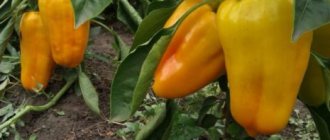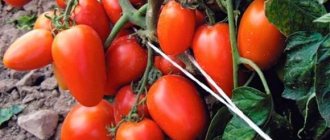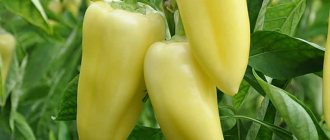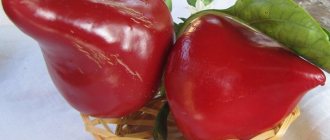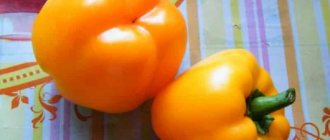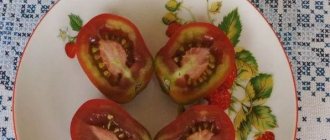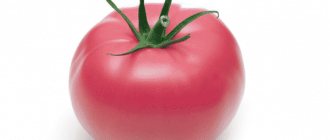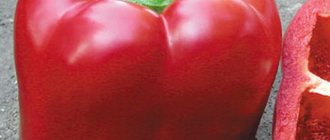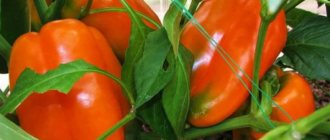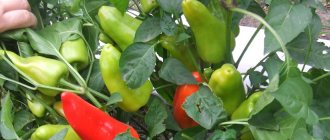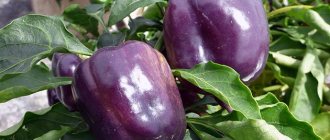History of the variety's creation
Viking bell pepper was bred by Russian breeders at the end of the last century. The originator of this variety is the West Siberian Vegetable Experimental Station VNIIOO, this institution is located in the Altai Territory, Barnaul. She is also the applicant for the variety to be included in the State Register of Russia.
After breeding, the variety was presented for variety testing only in 2003; Viking bell peppers were tested in experimental plots for 3 years, and in 2006 it was entered into the State Register of Russia, assigned the number 9610492.
Viking pepper - photo
The variety is zoned for cultivation in the West Siberian, East Siberian and Far Eastern districts in film greenhouses and greenhouses, as well as in garden beds on private farms.
Brief information about the origin of the variety, general description
Viking pepper was developed in Russia. After a thorough check in 2006, the variety was officially registered in the State Register of the Russian Federation. The plant is adapted for fruiting in greenhouses and open ground, in beds under film.
The culture does not grow higher than 1 m. The bushes have several branches. The leaves are elongated, the main part of them is at the top. At one time, up to 4 fruits are formed on the plant.
Pepper without a sharp tip, resembles a thick cylinder. The average weight of one specimen does not reach 200 g. Fully ripe pepper is bright red. To increase shelf life, it is plucked from the bush about 20 days before full ripening. At this moment, the fruit has a light green color.
The vegetable has walls of medium thickness - no more than 0.5 mm. There are few seeds inside. They are small. No more than 4 nests. The pulp is rich, juicy, dense.
| Type of growth, bush height | Semi-standard (70 – 90 cm) |
| Ripe fruit color | Light green (technical maturity), red (biological) |
| Acceptable planting patterns | 60x50 cm, 40x40 cm, 50x35 cm |
| Weight, length and shape of the fruit | 86-105g, 11-12cm, thick cylinder |
| Ripening period, yield | Early ripening 98 – 118 (technical maturity), 6-8 kg/m2 |
| Drop off point | Uncovered and covered beds |
| Diseases | Resists tobacco mosaic virus and fungal diseases |
| Flowering type | Mixed |
Characteristics and description of the variety
This variety of bell pepper is early ripening
– from the moment of germination of the seed to the harvesting of ripe Viking products, it takes from 4 to 4.5 months. And you can harvest fruits at the stage of technical ripeness already 110 days after the sprouts appear.
The bushes are medium-sized, not spreading, compact, so they can be grown in low greenhouses.
At the same time, up to 4 fruits are tied on one bush. The ripening of peppers is amicable.
Photo of Viking pepper
The ripe fruits of this pepper are large in size, prism-shaped, with an average weight of about 190 g, but with good care you can also harvest peppers weighing 260-300 g. Their walls are small in thickness (about 4.5 mm), the variety is not thick-walled is. The color of the fruit at the stage of technical ripeness is green; as the peppers fully ripen, they become rich red. Their walls are smooth, even and with a characteristic shine.
The taste of ripe Viking fruits is wonderful
. The pulp is compact, juicy, its aroma is light peppery, there is no characteristic bitterness in the taste. The fruits are not prone to cracking even during heat treatment.
The harvested crop is of universal use; the fruits are added to salads and snacks, used in canning - for making lecho and other twists.
Ripe fruits tolerate transportation well over different distances; they can be stored in appropriate conditions longer than fruits of other varieties of bell peppers.
Pepper Viking - video
Since Viking pepper is not a hybrid, but a variety, vegetable growers collect seeds from ripe fruits for further planting
. It should be remembered that the germination rate of seed material collected from the beds is not too high and lasts for no more than 3 seasons. But vegetable growers recommend using the seeds of this vegetable crop collected in the fall for planting next year.
Characteristics
"Viking" is an early ripening variety of sweet pepper. Therefore, to receive the first fruits you will have to wait only 100 days (approximately). It is during this period that the seeds “transform” into “technically” mature fruits. Biological ripeness occurs after 120-140 days.
"Viking" bushes are medium in size, so the seeds can be planted even in greenhouse conditions or in beds covered with films. On one bush up to 50 cm high, 3-4 kg can grow. fruits
Read also: Onions for a feather at home: secrets and subtleties of growing
The shape of the fruit is prismatic, the surface is glossy, smooth. The weight of each fruit ranges from 200 g, and the thickness of the walls is approximately 4-5 mm. The color of Viking sweet peppers is deep red.
Viking pepper has the following features:
- It has a moderate, subtle sweetish taste;
- Inside contains dense fleshy pulp;
- Resistant to the negative effects of various pathogens;
- The skin does not crack under any (permissible) temperature conditions;
- Features increased productivity.
Interesting ! The hybrid differs from other peppers in that it can be eaten even at the stage of “technical” maturity - that is, eaten green. Moreover, such fruits will be completely devoid of bitter taste.
Advantages
The main advantages of Viking bell pepper include:
- early fruit ripening;
- the possibility of growing in greenhouses and greenhouses in regions with harsh climatic conditions;
- high productivity;
- Almost all ripening peppers have an excellent presentation;
- for further sowing, you can collect seeds from ripened fruits of the Viking variety;
- the variety is resistant to temperature fluctuations.
This bell pepper has no particular disadvantages, but many vegetable growers say that the walls of the harvested fruits are too thin.
Further care
Although Bogatyr is considered an easy variety to grow, the plants require little care. Regularly water, fertilize, tie up, and weed the soil to remove weeds. In order for the peppers to ripen quickly and grow well, you need:
- maintain favorable temperature conditions, especially in the greenhouse. It is necessary to open the windows, remove the shutters to reduce the heat and improve air circulation;
- create humidity. At low humidity, plants drop their inflorescences, grow poorly, and the stems become thin;
- In the morning 3-4 times a week, water the peppers with cool, settled water. You can use a drip irrigation system;
- feed the seedlings during flowering and after it with mineral fertilizers based on potassium, zinc, boron and iodine;
- remove excess leaves on the stem that interfere with the ripening of peppers.
Be sure to inspect the condition of the stems and leaves at least every other day. If feather signs of disease infection appear on them (blotches, white coating, holes), then the seedlings are immediately treated with a fungicidal agent or insecticide. Timely measures taken will preserve the yield and high quality of fruits.
Selecting a site for planting
When choosing a site for planting bell peppers, you should remember: this crop needs a place well lit by sunlight with fertile and loose soil.
You also need to follow the rules of crop rotation; the best predecessors for this vegetable crop are:
- onion;
- pumpkin;
- all varieties of cabbage;
- cucumbers
It can also be noted that good precursors for bell peppers are green manure, which improves the composition of the soil and is an excellent organic fertilizer.
You cannot grow peppers after potatoes, peppers and tomatoes. If it is not possible to grow peppers in a new place every year, then a large amount of organic matter is first added to the soil (up to 6-7 kg of humus or compost for each square of area).
Recommendations for cultivation
To plant this vegetable crop, it is recommended to choose light and fertile soil. The best predecessors for growing sweet peppers are cucumbers, onions, cabbage, and pumpkin.
Attention! It is not recommended to plant peppers of this variety in areas where potatoes, tomatoes or other types of peppers previously grew. If it is impossible to plant the plant in another place, you should fertilize the soil with a large amount of organic matter.
Seedlings for seedlings are sown in late February or early March. To disinfect the seeds, they should first be treated with a manganese solution. After this, you need to wrap the treated seeds in gauze moistened with water and place them in a warm place so that they hatch faster.
You should prepare seedling containers or peat pots in advance by filling them with soil mixture. For these purposes, you can use ready-made purchased land that is suitable for planting sweet peppers. Before planting the seeds, the soil is heated in the oven.
Attention! Sweet pepper seedlings do not adapt well after picking, so it is better to immediately plant the seeds in separate containers.
After this, you should water the soil well, cover the containers with glass or film material and place them in a warm, well-lit place with a temperature of +23-+25 degrees. After the first shoots appear, the shelter must be removed.
Seedlings should be fertilized for the first time after two or three leaves have formed on the stem. 30 days before the expected date of transfer to a permanent place, it needs to be hardened by taking it out onto the loggia or veranda, gradually increasing the time spent in the open air. Bushes should be planted in beds or in a greenhouse 65-70 days after the first shoots have sprouted.
The plant is planted in pre-prepared holes according to the 60x40 pattern. Thanks to this, the bushes will receive the necessary amount of nutrients. Before planting, the holes need to be filled with a mixture of soil and organic fertilizers. Then the plant is well watered and tied to a vertical support.
Since the variety is unpretentious in care, the only recommended agrotechnical measures are regular watering and fertilization (once or twice during the growing season). It is also advisable to loosen and weed the soil.
The first harvest can be harvested as early as July. And the plant will bear fruit until September.
Planting seedlings
It is better to grow this variety of bell pepper using seedlings.
. When planting purchased seeds, pre-sowing preparation is not required. But the seed material collected from your garden should first be kept for half an hour in a weak solution of potassium permanganate for disinfection, then placed briefly in a preparation to accelerate growth. Then you should wrap the seeds in a damp cloth for germination for 2-3 days.
It is better to purchase soil for planting Viking bell pepper seedlings in a specialized store - in this case, all the necessary fertilizers have already been added to it.
Important!
Seedlings are transplanted into open ground or a greenhouse at the age of 2 months. If the seedlings have outgrown, then they will not take root well in the new place and will get sick longer. As a result, the yield of such plants may decrease in the future.
Pepper seedlings have a very delicate root system that does not tolerate transplantation well - it takes a long time to take root in a new place, so experienced vegetable growers recommend immediately planting the seeds in separate peat cups, with which the grown seedlings are then transplanted to a permanent place in the garden or greenhouse.
While growing pepper seedlings, they should be fed at least 2 times.
. The seedlings are fed for the first time when they have at least 2 permanent leaves. Typically, urea or another preparation containing nitrogen is used as a fertilizer. The next feeding is carried out 12-14 days after the first, but no later than two weeks before transplanting the seedlings to a permanent place. As a fertilizer, you can use a solution of mullein diluted with water in a ratio of 1:10, or chicken manure diluted in a ratio of 1:15.
12-14 days before transplanting mature seedlings to a permanent place, they should begin to be hardened off. To do this, containers with plants are taken out into the fresh air for a short time at first, but the time the seedlings spend outside is gradually increased. In the last days before transplanting, the seedlings are left outside overnight.
Features of growing the variety
Pepper is a southern, heat-loving crop, but having reached the northern latitudes, it has “settled in”, but requires special attention.
Growing seedlings
If you are the owner of a heated greenhouse, then you can sow pepper seeds for seedlings in early March. In this case, backlighting is necessary. If there is no lighting, it is better to postpone sowing until the end of March.
Let's prepare the soil
In order for the seedling period to be successful, it is necessary to prepare in advance:
- planting soil;
- containers for sowing;
- a warm place for seeds to germinate;
- a cool, bright place to grow.
It is better to purchase seedling soil in the store. There are several reasons for this:
- Universal soil is balanced in nutrients;
- The soil is enriched with those microelements that are necessary specifically for seedlings;
- The mixture is tested for acidity, and its level is adjusted to the optimal ratio;
- Store-bought soils are prepared taking into account water and breathability;
- The soils have been tested for the presence of pathogenic microflora and treated with special preparations;
- The mixtures are ready for direct seed sowing.
If you trust yourself more, then the soil for sowing pepper seeds should consist of fresh compost, well-ripened humus and garden soil in a ratio of 1:1:1. To a bucket of this mixture add 1 kg of coarse sand, 1 kg of stove ash and 2 tbsp. spoons of superphosphate. It is advisable to prepare the soil mixture in the fall so that it has time to “ripen”. The mixture must be kept in a frost-free room. The soil microflora will process organic matter over the course of 5-6 months, and make the mineral components available for absorption by the young root system of seedlings.
Let's prepare the seed
If sowing with dry seed is practiced, then this should be done 2-3 weeks earlier than usual. In addition, if there is little seed and you are not sure of its germination, it is better to give preference to sowing with germination.
To germinate pepper seeds, simply place them in a flat container, on a damp cloth or moistened filter paper, wrap them in a plastic bag and send them to a place where the temperature will be maintained around the clock at 25-27 ᵒC. After 2-3 days, you need to remove the bag and sow on the ground only those seeds that have shown signs of life. Living and non-living seeds are easy to distinguish. Those that are suitable for sowing will be swollen and have a small white root, the rest will not show signs of life.
Sowing
Pepper seeds can be sown both in a common container and in individual cups.
If sowing is carried out in one container, then when the first pair of true leaves appear, the seedlings will need to be planted in individual cups.
May be interesting Pepper “Admiral Kolchak F1”: for those who prefer the minimum requirements of agricultural technology Growing bitter pepper at home: care features Pepper “Bychok”: a sought-after variety with high quality fruits
General sowing is carried out as follows:
- the container is filled with soil mixture;
- compact;
- seeds are placed on top at a distance of 1.5-2 cm from each other;
- cover with soil with a 1-1.5 cm ball;
- slightly compacted;
- spray with warm water from a spray bottle;
- covered with glass or film;
- put in a warm place for germination.
Individual sowing is carried out in a similar way, but one seed is placed in one glass with a capacity of at least 200 ml.
Transplanting Viking pepper seedlings into open ground
The beds for transplanting bell pepper seedlings are prepared in advance. To do this, organic matter is added to the soil, all plant residues are removed, the soil is dug up and loosened.
How to properly plant peppers in open ground - video
Between adjacent planting holes, you need to make a distance in rows of about 0.4 m, and the row spacing should be up to 0.5 m.
Immediately before planting, 30 g of complex mineral fertilizer, necessarily containing potassium and phosphorus, is added to each hole.
After planting, the plants are watered and mulched with a layer of humus or straw.
Viking pepper care and further cultivation
In the future, regular watering should be carried out; it is necessary that the top layer of soil is constantly moistened, but without stagnation of water in the soil.
Interesting!
The best varieties of hot hot peppers for open ground and home cultivation.
It is also necessary to loosen the soil around the pepper bushes, at the same time remove all weeds and add mulch so that the moisture from the soil evaporates more slowly.
When planting seedlings, pegs are driven in next to the planting hole to which the plants need to be tied. The garter is needed so that the shoots do not break under the weight of the ripening crop.
To increase the yield of this variety, the first buds on the bushes must be removed - this is a feature of the Viking bell pepper.
And to prevent the fruits from acquiring bitter notes, this variety should not be planted next to hot peppers - the bushes are cross-pollinated, and all the fruits acquire a bitter taste.
Growing
Viking bell peppers are an early variety, so seedlings need to be prepared in February. First, you need to soak the seeds for 2-3 days in a damp cloth; you should not keep them longer, as they may begin to become covered with mucus. These peppers do not like soil changes and transplants, so it is better to plant each seed in a separate container. If this is not possible, then maintain a distance of 7-10 cm between the rows; plants need space and air.
Peppers are very sensitive to the composition of the soil, so you need to keep in mind that it is preferable to plant peppers after some crops that grew in this place previously, for example, after:
- pumpkins;
- carrots;
- onions;
- cucumber or zucchini.
On the contrary, pepper reacts negatively to some crops, for example, to tomatoes or potatoes. Before planting, the soil must be loosened well, fertilized with mineral fertilizers or chicken droppings, and then watered.
Young plants can be planted in the ground 60-70 days after planting, that is, in early May. It can be grown in open ground, in a greenhouse or under film. When planting, maintain a distance between rows of at least 40 cm. Caring for Viking consists of fertilizing with mineral fertilizers 3-4 times per season, as well as proper watering. This variety does not need a lot of moisture, so it is better to dry it out a little rather than water it too much.
Sweet peppers bear fruit until October, and can be harvested from mid-July.
Rules for feeding sweet peppers
This variety of bell pepper should be fed once every 12-14 days. At the same time, the application of mineral and organic fertilizers is alternated. Usually, in the summer, liquid fertilizers are applied under the roots, and care must be taken that their drops do not fall on the foliage and stems.
The first feeding of pepper bushes is carried out 12-14 days after transplanting the seedlings to a permanent place
. For this, 4 tbsp. l. ammonium nitrate is diluted in a bucket of water, and the resulting solution is watered under the plants.
Care
In order for the plant to grow in a balanced manner and the harvest to be established systematically, the following is necessary:
- watering;
- feeding;
- bush formation.
Watering
Once transplanted into a garden or greenhouse, peppers need timely and regular watering. The soil lump should not dry out, but excessive “standing” water is contraindicated.
The best method of irrigation is drip. The system can be installed both in a greenhouse and in a garden.
To prevent moisture from evaporating, it is advisable to cover the soil at the base of the shoot with mulch.
Feeding
2-3 weeks after planting, the peppers need to be fed. To do this, make a solution of nitrogen fertilizers (ammonium nitrate, urea) 2 tbsp. spoons per 5 liters of water.
The second feeding is carried out after 2 weeks with organic fertilizers. To do this, dissolve 1 kg of cow, pig or horse manure in a bucket of water and pour 0.5 liters under each bush.
The next fertilizing is carried out again with mineral fertilizers. Nitrogen compounds are no longer used so as not to cause violent growth of the vegetative mass. Dilute 2 tbsp in a bucket of water. spoons of superphosphate and 1 tbsp. a spoonful of potassium sulfate.
The next feeding is again done with organic matter.
Alternating mineral and organic fertilizers has a beneficial effect on the growth and fruiting of peppers.
Reviews from those who planted Viking peppers
Sveta, 44 years old, Moscow region: I bought this variety by accident, one might say - for change, purchasing seeds of various vegetable crops for further planting in the garden. It was written on the bag that the bushes do not grow large, but this variety grew almost 1 m in height. After flowering, I tied up all the Viking bushes so that the stems would not break off under the weight of the ripening fruits. I did not expect a big harvest, since the summer period was quite cool. However, despite the weather conditions, I reaped a large harvest from the bushes of this variety, even surprising myself.
Olga, 39 years old, Kirov region: I have been growing this variety of bell pepper for several seasons. I can say that its yield does not depend on weather conditions and is equally high both in hot weather and in cool rainy weather. We harvest in mid-August, and the fruits are tasty and have no bitterness. However, I recommend obligatory gartering of bushes in the spring, as well as fertilizing during the season.
The Viking bell pepper variety is perfect for growing in Siberia and the Urals, where it can be grown not only in open ground garden beds, but also in greenhouse conditions
. The variety is early ripening, so its fruits have time to ripen even in short, cool summer conditions.
What gardeners say
Nadezhda, 29 years old, Perm
“I paid attention to Viking completely by accident. You could say, “I fell in love.” According to information from the manufacturer, the plants grow small, but mine grew almost 1.5 meters each. I had to tie it up. The summer was cold, and I didn’t expect a serious harvest. But “Viking” was very surprising - without fertilizing it produced a huge harvest! I recommend to all!"
Svetlana, 45 years old, Petushki
“I have been using Viking seedlings for more than seven years. There has never been a year when I was upset about the harvest. Each fruit is almost perfect - large, you really want to try it. I harvest in August, sometimes earlier. Moreover, if you collect before summer, then the fruits really do not have bitterness - everything is as written by the manufacturer. It’s very important to pay attention to tying up the bushes, since we didn’t do this the first time, and many bushes simply broke.”
“Viking” is one of the hybrid varieties of peppers that can be consumed even at the ripening stage. This is its most significant difference from other “brotherly” cultures. But, due to the short shelf life and the difficulty of transportation, the best option is to grow the crop in the country “for yourself.”
Read also: Eggplant Behemoth F1: variety description, photos, reviews
